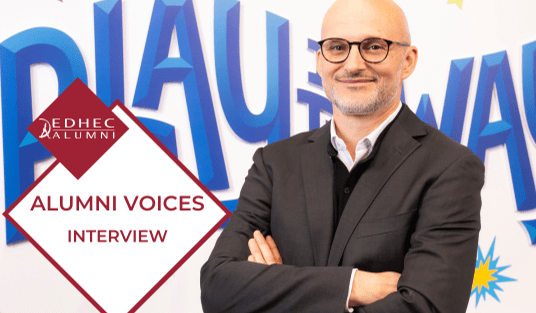Nicolas Houssin (EDHEC Master 1999), Vice-President of Marketing EMEA, Mattel
The nearly 22 years that Nicolas Houssin (EDHEC Master 1999) has already spent with Mattel have brought him into contact with all forms of marketing, which he now puts into practice as the head of an international region. Here we look back at Barbie, this summer’s big hit in cinemas and the media and based on the firm’s most famous brand (just one of many!), and consider the latest stakes for toy manufacturers in a society in which content wars are raging.
How would you sum up your current position and responsibilities?
I’m head of marketing for all of our categories and brands in the EMEA region (Europe, Middle East & Africa), with a team of around 130 people (digital communication, media, press relations, data analytics and brand management). The growth and marketing mix strategies which I help define are adapted and rolled out locally with our clients, retailers and agencies. Mattel has a huge catalogue of “intellectual property”, with many items inactive or dormant. There are around 25 brands that are active today, but we also develop many toys for cinema studios: Disney princess dolls, vehicles for Pixar’s Cars, Trolls dolls and Jurassic World dinosaurs for Universal.
In a digital world, what drives children (and their paying parents) to prefer a toy over a screen?
Many of our brands are transgenerational. Barbie turns 65 in 2024, Hot Wheels is over 50 years old, Fisher-Price more than 90. Parents nowadays are attached to the Mattel toys of their childhood and the memories they associate with them. Since the pandemic, they have been trying to reduce their children’s exposure to screens, and seem to value toys as a stimulating and educational alternative. But that doesn’t mean we have no on-screen presence! We are around wherever children spend time, and we do our best to tell interesting, fun and engaging stories across a wide range of media.
Would it be harder to draw children in without such a foothold in “devices”?
What engages children most of all is the storytelling that comes with toys, so they can play out their own stories again and again. Children don’t need much to come up with their own scenarios, or revisit what they have experienced in school, with their family or friends, etc. But we do look for other entry points through content (streaming, cinema, film platforms, series, TV, videogames, theme parks), which enables us to develop a brand and create experiences.
For parents, the purchase of a Barbie doll is generally influenced by the child, who might ask for one for Christmas or their birthday. However, the idea is also to create a connection with the parents so that they value the purchase of that brand over another because they associate certain values and advantages with it that extend beyond mere playtime.
Is it important for the firm’s credibility to show that it is not focused only on a product but on a much wider world?
Yes, and that is very much part of Mattel’s strategy. Children will spend time playing with their toys every day, but they do many other things, so you need to create a link where it counts. Furthermore, visibility may be important, but marketing only works if it carries meaning and authentic values. The success of the Barbie brand is due to the fact that since it was first created it has embodied women’s empowerment. When you play with a Barbie doll, anything becomes possible. Studies conducted in recent years have shown that from the age of 5, girls begin to think that a certain number of things aren’t meant for them, contrary to boys. This is what is known as the dream gap, and we have taken a number of initiatives with the aim of shaking things up, such as a scheme which each year celebrates female role models for what they have achieved in various business sectors. The raison d’être of Barbie is to open up and inspire the potential of children, girls in particular.
So would you say the release date of the Barbie film was opportune, coming after #MeToo and in a context in which the fight for women’s empowerment is more topical than ever?
The film wasn’t made in reaction to #MeToo. Mattel had for years wanted to make a film about Barbie. The director Greta Gerwig and Warner Bros. took an interest in the project, which is what allowed the film to get off the ground. The feminist angle came from Greta Gerwig, based on the values of Barbie. The film includes loads of references to Mattel and its history, which are the fruit of a collaborative process between Greta Gerwig, the main actress, Margot Robbie, Mattel Films and Warner Bros. But Greta Gerwig’s creative approach was completely independent. The film reflects her vision, it’s what she wanted to do. There were undoubtedly discussions about certain scenes, which may have left some viewers uneasy, but we just have to accept that. It is not and could never have been a film advertisement for Mattel.
Has the film’s success had consequences for Mattel’s marketing objectives?
Yes, of course. Mattel, Hasbro (Transformers and G.I. Joe franchises) and LEGO (The Lego Movie, The Lego Batman Movie, etc.) know that films have an incredible impact on brand notoriety. This film has generated revenue, but the main idea is to capitalise on the moment to sell our toys. It has proven to be more than a film, a cultural event beyond our expectations. And it’s not over yet, because Barbie is due to be released on all platforms at Christmas, after an initial release on premium platforms. It has also enabled us to develop the sale of derivative products beyond the toy market, designed for adults and fans: fashion items, shoes, accessories, decorations, etc. The film is not only for children, it’s for everyone, those who love Barbie and those who are not too keen. There is a kind of halo effect on the sale of toys for children, because an event like this one generates top-of-mind awareness. Barbie has always generated comment, both good and bad. We knew that a production all about Barbie would have a different impact compared to any other one of our brands, because of what she represents, people’s perception of her and the film’s strong discourse.
Is the film’s discourse – or the director’s – also the one that Mattel wants to embrace?
The film’s discourse really is linked to the history of the Barbie brand. Before Barbie – the first fashion doll –, little girls could only play dolls with newborns. There wasn’t a doll out there that would allow them to project themselves into the adult world. Inclusiveness is also a very strong value at Mattel. We spend an increasing amount of time and energy ensuring that our brands represent the world as it is, as children see it. Some people still see Barbie as simply a blonde doll. The truth is that there are loads of dolls under the Barbie brand, with different hair, origins, body shapes, disabilities, etc. Huge efforts in terms of design have been made in the United States to make the offer more inclusive.
Does that also involve degendering toys? Making sure that a particular type of toy is not associated only with girls or boys?
The European Commission and many others are now taking an interest in this issue, and we are trying to be much less prescriptive about “who” can play. If only girls feature in a Barbie ad or packaging, it will be difficult for a boy to imagine himself playing with one. With two girls and a boy playing together, it’s immediately different. Pink is so closely associated with Barbie that the right balance needs to be struck, but the idea is to be as inclusive as possible in our advertising campaigns.
Is the Mattel Cinematic Universe plan for 16 feature-length films (about UNO, Polly Pocket, Masters of the Universe, Hot Wheels and others) about trying to carve out a niche in pop culture?
Mattel is above all a toy manufacturer. But we are still trying to build brand franchises which resonate beyond the toy itself. Films are a way to reach fans, adults, collectors, as well as children. “Kidults”, whose childhood is behind them (teenagers, young adults, adults, collectors), represent almost one-third of the toy market, a segment enjoying huge growth. Our transgenerational brands are justified in also targeting these consumers, whether with content or products. Our Mattel Creations platform reaches out to this audience and regularly releases limited series items in collaboration with artists. This is how, with one-off events, our brands are entering pop culture, creating and sustaining a privileged relationship with fans.
Your LinkedIn profile says “I believe in kindness”. Would you say that is the future of a firm in good health?
I believe strongly in benevolence, creating an environment of empathy in which people feel free to be themselves and express their opinions even if they’re different. I think that in a firm, intentions can be assumed to be positive: nobody shows up to do a bad job. The notion of psychological safety is firmly rooted in Mattel. It is of the utmost importance to create a culture in which people want to come in and have a positive impact, where they can challenge things and make suggestions. If you don’t believe in such an environment, I doubt you can produce positive results in the long term.

Comments0
Please log in to see or add a comment
Suggested Articles



